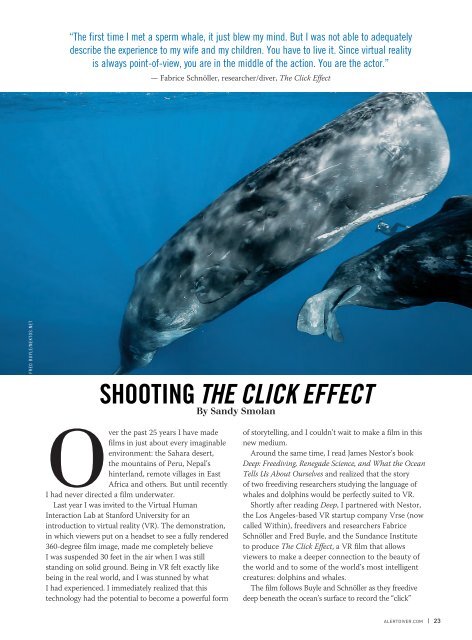AD 2016 Q3
Alert Diver is the dive industry’s leading publication. Featuring DAN’s core content of dive safety, research, education and medical information, each issue is a must-read reference, archived and shared by passionate scuba enthusiasts. In addition, Alert Diver showcases fascinating dive destinations and marine environmental topics through images from the world’s greatest underwater photographers and stories from the most experienced and eloquent dive journalists in the business.
Alert Diver is the dive industry’s leading publication. Featuring DAN’s core content of dive safety, research, education and medical information, each issue is a must-read reference, archived and shared by passionate scuba enthusiasts. In addition, Alert Diver showcases fascinating dive destinations and marine environmental topics through images from the world’s greatest underwater photographers and stories from the most experienced and eloquent dive journalists in the business.
You also want an ePaper? Increase the reach of your titles
YUMPU automatically turns print PDFs into web optimized ePapers that Google loves.
“The first time I met a sperm whale, it just blew my mind. But I was not able to adequately<br />
describe the experience to my wife and my children. You have to live it. Since virtual reality<br />
is always point-of-view, you are in the middle of the action. You are the actor.”<br />
— Fabrice Schnöller, researcher/diver, The Click Effect<br />
FRED BUYLE/NEKTOS.NET<br />
SHOOTING THE CLICK EFFECT<br />
By Sandy Smolan<br />
Over the past 25 years I have made<br />
films in just about every imaginable<br />
environment: the Sahara desert,<br />
the mountains of Peru, Nepal’s<br />
hinterland, remote villages in East<br />
Africa and others. But until recently<br />
I had never directed a film underwater.<br />
Last year I was invited to the Virtual Human<br />
Interaction Lab at Stanford University for an<br />
introduction to virtual reality (VR). The demonstration,<br />
in which viewers put on a headset to see a fully rendered<br />
360-degree film image, made me completely believe<br />
I was suspended 30 feet in the air when I was still<br />
standing on solid ground. Being in VR felt exactly like<br />
being in the real world, and I was stunned by what<br />
I had experienced. I immediately realized that this<br />
technology had the potential to become a powerful form<br />
of storytelling, and I couldn’t wait to make a film in this<br />
new medium.<br />
Around the same time, I read James Nestor’s book<br />
Deep: Freediving, Renegade Science, and What the Ocean<br />
Tells Us About Ourselves and realized that the story<br />
of two freediving researchers studying the language of<br />
whales and dolphins would be perfectly suited to VR.<br />
Shortly after reading Deep, I partnered with Nestor,<br />
the Los Angeles-based VR startup company Vrse (now<br />
called Within), freedivers and researchers Fabrice<br />
Schnöller and Fred Buyle, and the Sundance Institute<br />
to produce The Click Effect, a VR film that allows<br />
viewers to make a deeper connection to the beauty of<br />
the world and to some of the world’s most intelligent<br />
creatures: dolphins and whales.<br />
The film follows Buyle and Schnöller as they freedive<br />
deep beneath the ocean’s surface to record the “click”<br />
ALERTDIVER.COM | 23









